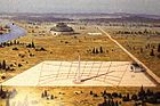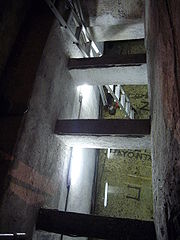
Solarium Augusti
Encyclopedia
The Solarium Augusti was a sundial
in ancient Rome
, the largest of the ancient era. It was erected by Emperor Augustus
, with a 30-metre Egyptian red granite obelisk
that he had imported from Heliopolis
. The obelisk was employed as a gnomon
that cast its shadow on a marble pavement inlaid with a gilded bronze network of lines, by which it was possible to read the time of day according to the season of the year. The solarium was dedicated to the Sun
in 10 BC, shortly after Julius Caesar's calendar reform
. It was the first solar dedication in Rome.
 The Solarium Augusti was integrated with the Ara Pacis
The Solarium Augusti was integrated with the Ara Pacis
, aligning with Via Flaminia
, in such a way that the shadow of the gnomon fell across the center of the marble altar on 23 September, the birthday of Augustus himself. The obelisk itself was set up to memorialize Augustus' subordination of Egypt to the control of the Roman empire. The two monuments must have been planned together, in relation to the pre-existing Mausoleum of Augustus
, to demonstrate that Augustus was "born to bring peace", that peace was his destiny
. According to the Cambridge Ancient History, "the collective message dramatically linked peace with military authority and imperial expansion."
Pliny the Elder
remarked that in the course of time it had become incorrect, and offered several explanations for the shift. The obelisk was illustrated, supported by a reclining figure, on the base of the Column of Antoninus Pius
; it was still standing in the eighth century, but was thrown down and broken, then covered in sediment; it was rediscovered in 1512, but not excavated. In a triumphant rededication, the obelisk
, now one of the most prominent obelisks of Rome, was re-erected in Piazza di Montecitorio by Pius VI
in 1789.
Edmund Buchner
excavated some sections of the calibrated marble pavement of the Solarium Augusti under the block of houses between Piazza del Parlamento and Piazza San Lorenzo in Lucina.
A broad context for the iconographic programme of which the Solarium Augusti is part is offered in Paul Zanker, The Power of Images in the Age of Augustus (University of Michigan Press), 1988.
Sundial
A sundial is a device that measures time by the position of the Sun. In common designs such as the horizontal sundial, the sun casts a shadow from its style onto a surface marked with lines indicating the hours of the day. The style is the time-telling edge of the gnomon, often a thin rod or a...
in ancient Rome
Ancient Rome
Ancient Rome was a thriving civilization that grew on the Italian Peninsula as early as the 8th century BC. Located along the Mediterranean Sea and centered on the city of Rome, it expanded to one of the largest empires in the ancient world....
, the largest of the ancient era. It was erected by Emperor Augustus
Augustus
Augustus ;23 September 63 BC – 19 August AD 14) is considered the first emperor of the Roman Empire, which he ruled alone from 27 BC until his death in 14 AD.The dates of his rule are contemporary dates; Augustus lived under two calendars, the Roman Republican until 45 BC, and the Julian...
, with a 30-metre Egyptian red granite obelisk
Obelisk
An obelisk is a tall, four-sided, narrow tapering monument which ends in a pyramid-like shape at the top, and is said to resemble a petrified ray of the sun-disk. A pair of obelisks usually stood in front of a pylon...
that he had imported from Heliopolis
Heliopolis (ancient)
Heliopolis was one of the oldest cities of ancient Egypt, the capital of the 13th Lower Egyptian nome that was located five miles east of the Nile to the north of the apex of the Nile Delta...
. The obelisk was employed as a gnomon
Gnomon
The gnomon is the part of a sundial that casts the shadow. Gnomon is an ancient Greek word meaning "indicator", "one who discerns," or "that which reveals."It has come to be used for a variety of purposes in mathematics and other fields....
that cast its shadow on a marble pavement inlaid with a gilded bronze network of lines, by which it was possible to read the time of day according to the season of the year. The solarium was dedicated to the Sun
Sun
The Sun is the star at the center of the Solar System. It is almost perfectly spherical and consists of hot plasma interwoven with magnetic fields...
in 10 BC, shortly after Julius Caesar's calendar reform
Julian calendar
The Julian calendar began in 45 BC as a reform of the Roman calendar by Julius Caesar. It was chosen after consultation with the astronomer Sosigenes of Alexandria and was probably designed to approximate the tropical year .The Julian calendar has a regular year of 365 days divided into 12 months...
. It was the first solar dedication in Rome.

Ara Pacis
The Ara Pacis Augustae is an altar to Peace, envisioned as a Roman goddess...
, aligning with Via Flaminia
Via Flaminia
The Via Flaminia was an ancient Roman road leading from Rome over the Apennine Mountains to Ariminum on the coast of the Adriatic Sea, and due to the ruggedness of the mountains was the major option the Romans had for travel between Etruria, Latium and Campania and the Po Valley...
, in such a way that the shadow of the gnomon fell across the center of the marble altar on 23 September, the birthday of Augustus himself. The obelisk itself was set up to memorialize Augustus' subordination of Egypt to the control of the Roman empire. The two monuments must have been planned together, in relation to the pre-existing Mausoleum of Augustus
Mausoleum of Augustus
The Mausoleum of Augustus is a large tomb built by the Roman Emperor Augustus in 28 BC on the Campus Martius in Rome, Italy. The Mausoleum, now located on the Piazza Augusto Imperatore, is no longer open to tourists, and the ravages of time and carelessness have stripped the ruins bare...
, to demonstrate that Augustus was "born to bring peace", that peace was his destiny
Destiny
Destiny or fate refers to a predetermined course of events. It may be conceived as a predetermined future, whether in general or of an individual...
. According to the Cambridge Ancient History, "the collective message dramatically linked peace with military authority and imperial expansion."
Pliny the Elder
Pliny the Elder
Gaius Plinius Secundus , better known as Pliny the Elder, was a Roman author, naturalist, and natural philosopher, as well as naval and army commander of the early Roman Empire, and personal friend of the emperor Vespasian...
remarked that in the course of time it had become incorrect, and offered several explanations for the shift. The obelisk was illustrated, supported by a reclining figure, on the base of the Column of Antoninus Pius
Column of Antoninus Pius
The Column of Antoninus Pius is a Roman honorific column in Rome, Italy, devoted in 161 to the Roman emperor Antoninus Pius, in the Campus Martius, on the edge of the hill now known as Monte Citorio, and set up by his successors, the co-emperors Marcus Aurelius and Lucius Verus.-Construction:The...
; it was still standing in the eighth century, but was thrown down and broken, then covered in sediment; it was rediscovered in 1512, but not excavated. In a triumphant rededication, the obelisk
Obelisk of Montecitorio
The Obelisk of Montecitorio is an ancient Egyptian, red granite obelisk of Psammetichus II from Heliopolis. Brought to Rome with the Flaminian obelisk in 10 BC by the Roman Emperor Augustus to be used as the gnomon of the Solarium Augusti, it is now in the Piazza Montecitorio...
, now one of the most prominent obelisks of Rome, was re-erected in Piazza di Montecitorio by Pius VI
Pope Pius VI
Pope Pius VI , born Count Giovanni Angelo Braschi, was Pope from 1775 to 1799.-Early years:Braschi was born in Cesena...
in 1789.
Edmund Buchner
Edmund Buchner
Edmund Buchner is a German ancient historian and former President of the German Archaeological Institute ....
excavated some sections of the calibrated marble pavement of the Solarium Augusti under the block of houses between Piazza del Parlamento and Piazza San Lorenzo in Lucina.
A broad context for the iconographic programme of which the Solarium Augusti is part is offered in Paul Zanker, The Power of Images in the Age of Augustus (University of Michigan Press), 1988.
External links
- Paul Zanker, "The Augustan Program of Cultural Renewal (part two). The Solarium Augusti in the context of Augustan monuments.
- Project to construct a full-scale replica on the campus of the University of Oregon, Eugene
- "The Horologium of Augustus: a bibliography"
- Horologium of Augustus, part of the Encyclopædia Romana by James Grout
- Meridian vs. Horologium-Solarium

